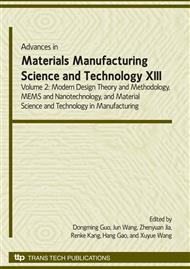p.197
p.203
p.209
p.215
p.221
p.227
p.233
p.239
p.245
Thermal Analysis on Rolling Bearing Chock in the Strip Mill
Abstract:
The heat deformation failure form of workroll bearing chock in Bao Shan steel 2050mm hot strip mill was studied by using finite element method. This phenomenon indicates that the internal friction heat in the bearing is the major heat source that results in temperature rise. With the establishment of reasonable temperature boundary conditions on free and contact surfaces, the heat conduction model of bearing chock was built and discreted. By means of finite element method and three dimensional FEM program, the rules of temperature distribution and heat stress distribution of bearing chock were discussed. Moreover, some suggestions on bearing improvement were brought up.
Info:
Periodical:
Pages:
221-226
Citation:
Online since:
August 2009
Authors:
Price:
Сopyright:
© 2009 Trans Tech Publications Ltd. All Rights Reserved
Share:
Citation:


